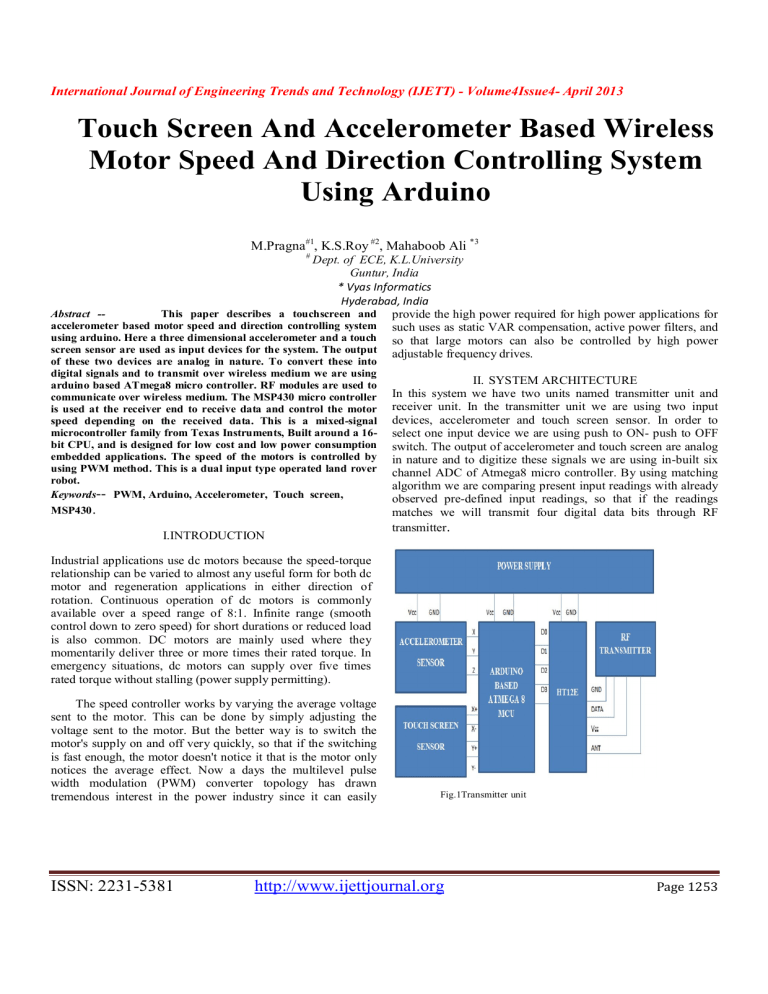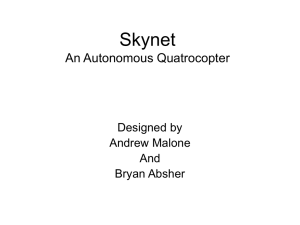Touch Screen And Accelerometer Based Wireless Using Arduino

International Journal of Engineering Trends and Technology (IJETT) - Volume4Issue4- April 2013
Touch Screen And Accelerometer Based Wireless
Motor Speed And Direction Controlling System
Using Arduino
M.Pragna
#1
, K.S.Roy
#2
, Mahaboob Ali
*3
#
Dept. of ECE, K.L.University
Guntur, India
* Vyas Informatics
Hyderabad, India
Abstract -- This paper describes a touchscreen and provide the high power required for high power applications for accelerometer based motor speed and direction controlling system using arduino. Here a three dimensional accelerometer and a touch screen sensor are used as input devices for the system. The output of these two devices are analog in nature. To convert these into digital signals and to transmit over wireless medium we are using arduino based ATmega8 micro controller. RF modules are used to communicate over wireless medium. The MSP430 micro controller is used at the receiver end to receive data and control the motor speed depending on the received data.
This is a mixed-signal microcontroller family from Texas Instruments, Built around a 16bit CPU, and is designed for low cost and low power consumption embedded applications. The speed of the motors is controlled by using PWM method. This is a dual input type operated land rover robot. such uses as static VAR compensation, active power filters, and so that large motors can also be controlled by high power adjustable frequency drives.
In this system we have two units named transmitter unit and receiver unit. In the transmitter unit we are using two input devices, accelerometer and touch screen sensor. In order to select one input device we are using push to ON- push to OFF switch. The output of accelerometer and touch screen are analog in nature and to digitize these signals we are using in-built six channel ADC of Atmega8 micro controller. By using matching
Keywords
MSP430 .
--
PWM, Arduino, Accelerometer, Touch screen,
II.
SYSTEM ARCHITECTURE algorithm we are comparing present input readings with already observed pre-defined input readings, so that if the readings matches we will transmit four digital data bits through RF transmitter .
I.INTRODUCTION
Industrial applications use dc motors because the speed-torque relationship can be varied to almost any useful form for both dc motor and regeneration applications in either direction of rotation. Continuous operation of dc motors is commonly available over a speed range of 8:1. Infinite range (smooth control down to zero speed) for short durations or reduced load is also common. DC motors are mainly used where they momentarily deliver three or more times their rated torque. In emergency situations, dc motors can supply over five times rated torque without stalling (power supply permitting).
The speed controller works by varying the average voltage sent to the motor. This can be done by simply adjusting the voltage sent to the motor. But the better way is to switch the motor's supply on and off very quickly, so that if the switching is fast enough, the motor doesn't notice it that is the motor only notices the average effect. Now a days the multilevel pulse width modulation (PWM) converter topology has drawn tremendous interest in the power industry since it can easily Fig.1Transmitter unit
ISSN: 2231-5381 http://www.ijettjournal.org
Page 1253
International Journal of Engineering Trends and Technology (IJETT) - Volume4Issue4- April 2013
In the receiver unit RF receiver will receive four data bits from transmitter and depending on the received data bits motor speed will be controlled. This is processed by using MSP430 controller. But micro controller cannot control motor directly in between it needs a driver circuit to drive the motors. Therefore to drive the motors L293D IC is used.
In this project we are using touch screen as an input device for the system. First we will observe the analog values for different positions on touch screen. Depending on these values complete touch screen module is divided into four quadrants, for each quadrant we will assign the duty cycle at receiver end. , when we touch in 1 st
quadrant motor runs with 100% duty cycle, when we touch in 2 nd
quadrant motor runs with 75% duty cycle, when we touch in 3 rd
quadrant motor runs with 50% duty cycle, and when 4 th
quadrant is pressed motor runs with 25% duty cycle.
B. Accelerometer Gesture Recognition
Fig.2 Receiver circuit
A.Touch Screen Sensor
Touch screen sensors are composed of a transparent touch screen surface surrounded by a sensor array that provides positional information to a processor. A touch screen sensor allows the display to be used as input device and replaces the keyboard or mouse as the primary method of input for interacting with a display's content. Touch screen technology is used by banks in the form of automatic teller machines (ATMs).
Accelerometer sensor is used for gesture recognition.
Accelerometer is a device that measures the vibration, or acceleration of motion and gives out different voltage levels.
The force caused by vibration or a change in motion
(acceleration) causes the mass which produces an electrical charge that is proportional to the force exerted upon it. As the charge is proportional to the force, and the mass is a constant, then the charge is also proportional to the acceleration.
In this project we are using ADXL335 accelerometer which is a
3-dimensional accelerometer. ADXL335 measures acceleration in three dimensions say X,Y and Z and produces three different voltage levels. The accelerometer output is analog in nature and to digitize these signals we are using a ADC that is in-built in
Atmega8 micro controller.
Here, Atmega8 microcontroller continuously read data from accelerometer and convert them into digital form. This digital data is compared with the data which is already taken in the accelerometer analysis part. And for every position of accelerometer four data bits are assigned. Now, in the comparison phase digital data is compared with the pre-defined ranges, and for matched range corresponding data bits will be transmitted through ISM band RF transmitter.
Fig.3 Touch screen
ISSN: 2231-5381 http://www.ijettjournal.org
Page 1254
International Journal of Engineering Trends and Technology (IJETT) - Volume4Issue4- April 2013
Fig.5 Receiver flow chart
IV. SAMPLE ARDUINO SOFTWARE PAGE
:
Fig.4Flow chart for gesture recognition when the accelerometer is in forward direction duty cycle is
100%, when it is in right direction duty cycle is 75%, when it is in left direction duty cycle is 50%, and when it is in back direction duty cycle is 25%
III. PWM IMPLEMENTATION
At the receiver end, RF receiver will receive data bits from transmitter and it compares received data with pre-defined data.
Using this Artificial Neural Network schema, MSP430 micro controller will control the duty cycle of motor. Below figure shows the flow chart for received data bits and processing in the receiver end.
V APPLICATIONS:
ISSN: 2231-5381 http://www.ijettjournal.org
Page 1255
International Journal of Engineering Trends and Technology (IJETT) - Volume4Issue4- April 2013
It is a gesture recognition system. It has many applications in the field of Robot racing. Both Accelerometer and Touch Screen comes under the gesture recognition category. Accelerometer is based on sensing the position and Touch screen is based on sensitivity. Touch screen is an emerging technology and it has a future scope in Robotics. You can also apply this concept to the
Humanoid Robots.
VI. CONCLUSION AND FUTURE SCOPE:
Finally I conclude by saying that Gesture Recognition system is one of the most advanced systems in the field of
Robotics. Up to now we had made several land rover robots using wired and wireless but, this is the upcoming technology of controlling the speed and movement of the Robots using the movements of Accelerometer and Touch Screen Technologies.
By using this features of gesture technology, we can also modify it to advanced robots using Haptic Technology. Haptic
Technology is nothing but virtual implementation of giving commands to Robots with hand movements. We have a vast scope of Robotics in the field of Haptics.
ACKNOWLEDGMENT
I am thankful to Mr. K Sripath Roy and Mr.
Mahaboob Ali for their guidance in preparing this paper.
REFERENCES
[1].
J. Holtz “Pulse width modulation for electric power conversion”,
Proc.IEEE, vol.82, pp.1194-1214, Aug. 1994.
[2].
J. O. P. Pinto, B. K. Bose, L. E. B. Silva, M. P. Karmierkowski “A
Neural Network Based Space Vector PWM Controller for Voltage-
Fed Inverter Induction Motor Drive”, IEEE Trans. on Ind. Appl., vol.36, no. 6, November/December 2000.
[3].
A. Bakhshai, J. Espinoza, G. Joos, H. Jin. “A combined ANN and
DSP approach to the implementation of space vector modulation techniques”, in conf. Rec.IEEE –IAS Annu. Meeting, 1996, pp.934-
940.
[4].
Zhang Yan-sectorg , LinFei, „„Comparison of two space vector pulse width over modulation methods ‟‟, Journal of BeiJingJiaoTong
University, China. 2005, 9(2) : 39-43.
[5].
Tong Yi bing, Liu Jing dou, „„Study of continuous control of space voltage vector PWM during over modulation period ‟‟, Electric drive for locomotives, China. 2004, 3 : 21-23.
[6].
Zhang Liwei, Liu Jun, „„A novel algorithm of SVPWM inverter in the over-modulation region based on fundamental voltage amplitude linear output control ‟‟, Proceedings of the CSEE, China,
2005, 25(19) : 12-18.
[7].
Cong wang, B.K,Bose, V.O.,Mondal, J.O.P.Pinto, „„Neur- network based space-vector PWM of a three level inverter covering over modulation region and performance evaluation on induction motor drive ‟‟, IEEE Trans. On Ind.Applieat
, 2003 : l-6.
[8].
Pan Ting long, JI Zhicheng, XIE Lin bo, Shen Yan xia, „„Design of novel ANN based SVPWM controller ‟‟, Journal of System
SimulationVb1.18No.2 Feb.2006: 420-423
ISSN: 2231-5381 http://www.ijettjournal.org
Page 1256




